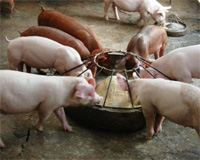Research: Particle size and enzymes effect on digestibility in pigs

A combined Vietnamese-Swedish research team studied the influence of particle size and multi-enzyme supplementation of fibrous diets on total tract digestibility and performance of weaning (8–20 kg) and growing (20–40 kg) pigs.
The aim of the study was to evaluate the effects of fibre source (cassava residue, CR and sweet potato vines, SPV), particle size (1 mm and 3 mm screen size) and multi-enzyme supplementation (mixture of α-amylase, β-glucanase, cellulase and protease) on growth performance and the coefficient of total tract apparent digestibility (CTTAD) in weaning and growing pigs (Landrace × Yorkshire).
Trial setup
The experimental diets were based on maize, fish meal, full fat soybean, soybean meal, soybean oil and CR or SPV.
The dietary levels of CR and SPV were 200 and 350 g/kg (as fed) in the post-weaning and growing period, respectively.
The experiment was arranged according to a 2×2×2 factorial completely randomized design with five replications, and lasted 60 days with two periods: from 30 to 60 days of age (post-weaning) and 60 to 90 days of age (growing).
Results
In each period, pigs fed the CR diet had higher CTTAD of dietary components (except for ether extract), average daily gain and lower feed conversion ratio than those fed the SPV diet.
In each period, pigs fed the CR diet had higher CTTAD of dietary components (except for ether extract), average daily gain and lower feed conversion ratio than those fed the SPV diet.
The reduction in particle size increased the CTTAD of dietary components and average daily gain in the post-weaning period, but not in the growing period.
Addition of the enzyme mixture improved the CTTAD and growth performance in the post-weaning period.
There was an interaction between particle size and multi-enzyme supplementation on the CTTAD of crude protein and neutral detergent fibre in the post-weaning period, such that multi-enzyme supplementation increased the CTTAD of CP and NDF in the larger particle size diet (0.80 versus 0.75, and 0.58 versus 0.51, respectively), while there was no change in the small particle size diet (0.80 versus 0.78, and 0.59 versus 0.55, respectively).
However, in the growing period multi-enzyme supplementation had no positive effect on the performance and the CTTAD of dietary components, with the exception of the CTTAD of crude protein and neutral detergent fibre.
Conclusion
A reduction in particle size and multi-enzyme supplementation improved the CTTAD of dietary components and the growth performance in the post-weaning period, but not in the growing period.











